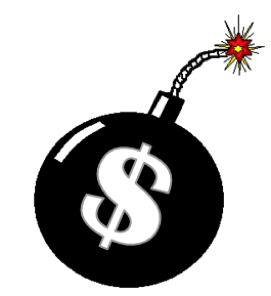In Japan, the 10-year treasury has been negative for several days now. On Feb. 29 the government sold its first auction at a negative rate, about $19.5 billion at a -0.024 percent rate, as reported by Bloomberg Business. At that rate the government will actually get paid about $4.7 million annually for the next ten years.
Welcome to the upside down world of negative interest rates, where it pays for governments to go deeper into debt.
For now, it’s just relatively small sums of money but consider the bizarre incentives that begin to mount the further negative rates plunge in the coming years.
In the U.S., refinancing the now $19 trillion debt at -2.5 percent would yield the government an additional $475 billion of revenue. That would practically balance the budget, considering it would simultaneously eliminate the $402 billion of gross interest already owed, reducing spending by that amount.
Instead of a 2015 deficit of $438 billion, then, technically the government would wind up with a budget surplus — you read that right — of $439 billion.
Sounds dumb, right? Who would pay our reckless government to borrow money? It’s insane.
Rates need not even go that low. Simply refinancing at a -0.2 percent rate would still eliminate all interest costs on the debt, and balance the budget immediately with the additional $38 billion in revenue.
Free money for governments to waste might explain in part or in whole why central banks in Europe and Japan are now experimenting with the negative rates. But what about the consequences?
For example, about $5.3 trillion of U.S. treasuries actually sit in the Social Security and Medicare trust funds. Those would suddenly stop earning interest and suddenly start paying it, becoming a net drain on the trust funds.
To compensate, the trust funds would have to gradually purchase higher yielding, riskier bonds or equities to keep everything solvent. In other words, the lower interest rates go, the less solvent the trust funds become.
Then, there’s the broader problem of retirement and pension funds that depend on U.S. treasuries for interest income. They too would need to find something else to invest in.
Also, one must consider all of the financial institutions that wouldn’t be borrowing from the Fed at negative rates to purchase treasuries, and what ends up happening is the private market for treasuries dies.
Perhaps they might get paid to borrow in order to pay interest to their clients. Who knows?
Which brings us to the endgame.
All that would remain would be central banks either directly purchasing the treasuries, or paying institutions to borrow to buy the bonds. Either way, it would be a direct monetization of the debt. Helicopter money. Not to mention homeowners getting paid the larger their mortgage is. Consumers getting extra income for being wasteful.
It sounds ridiculous. But it’s already happening. And unless Congress acts to prohibit the practice, negative rates might be coming to a Federal Reserve branch or treasury auction near you — sooner than you think.
Robert Romano is the senior editor of Americans for Limited Government.







